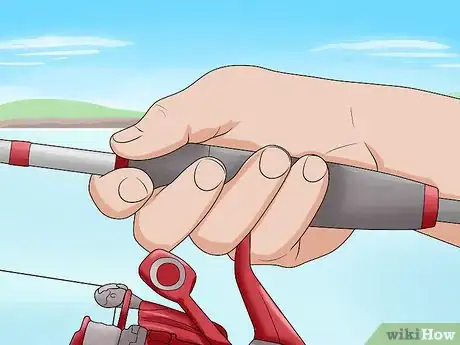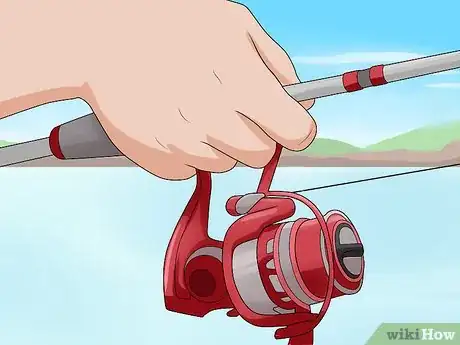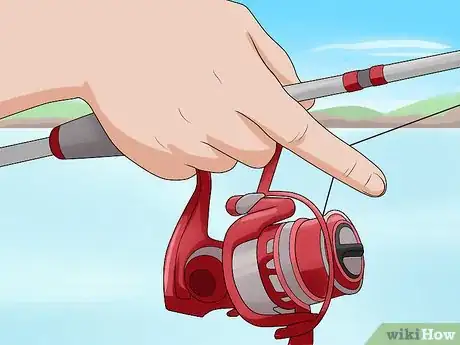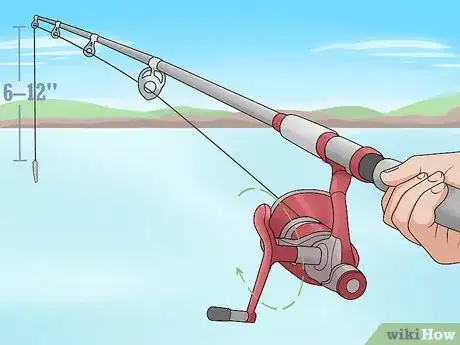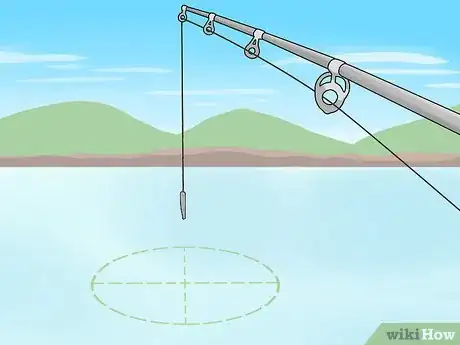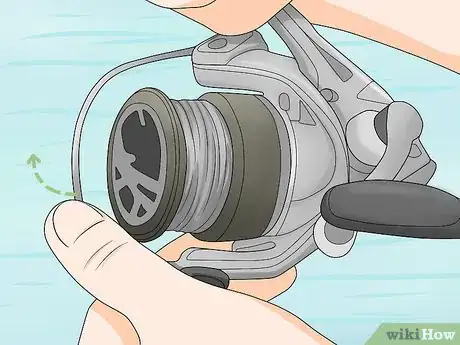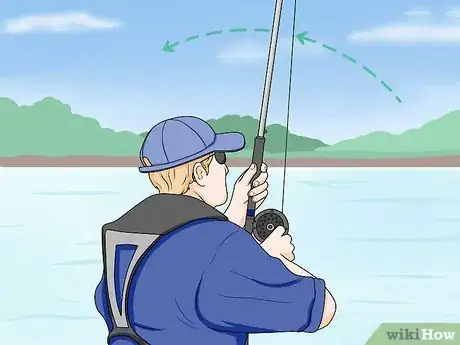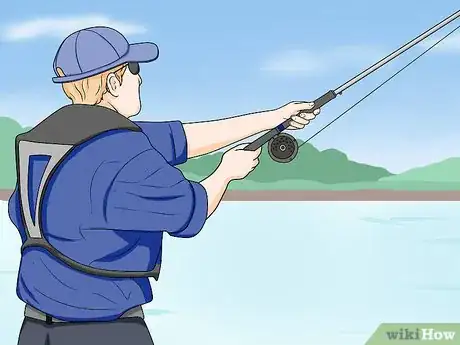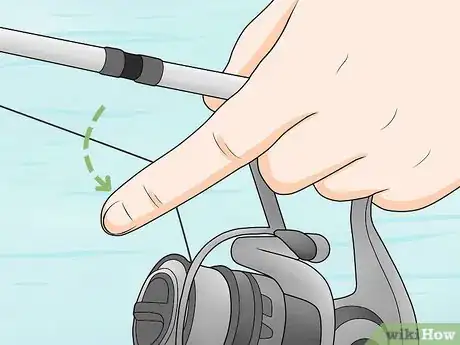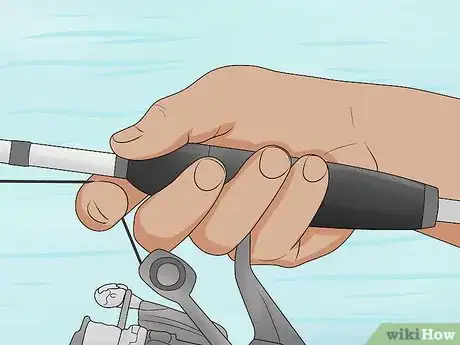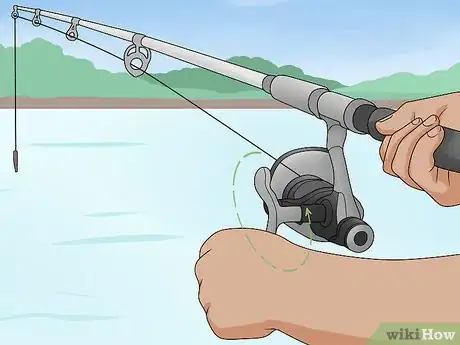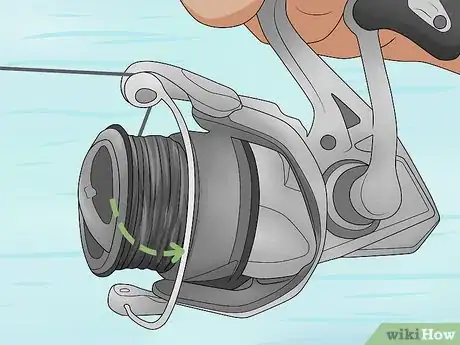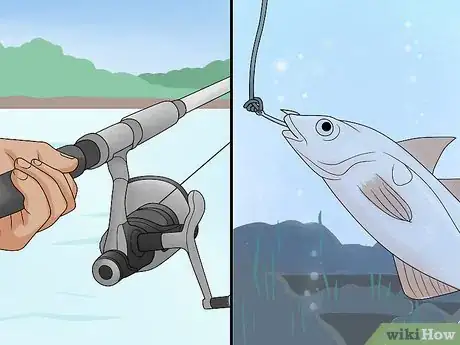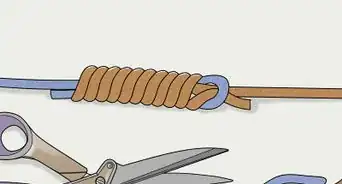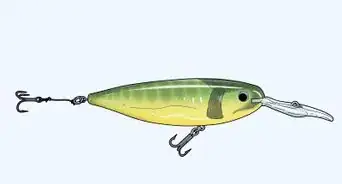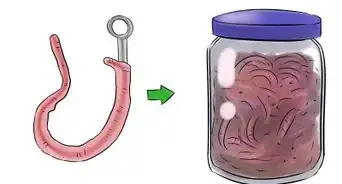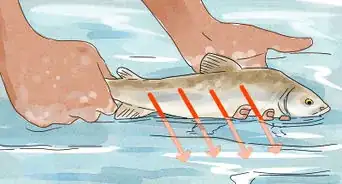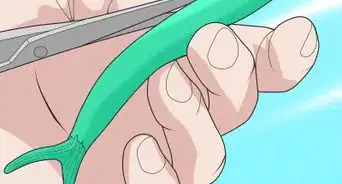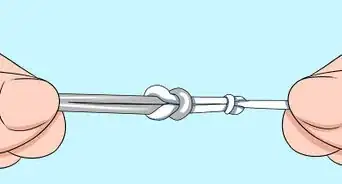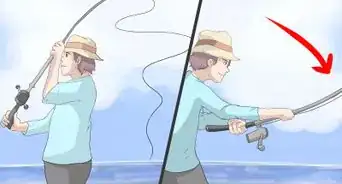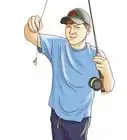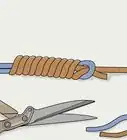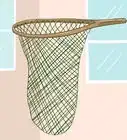This article was co-authored by wikiHow staff writer, Eric McClure. Eric McClure is an editing fellow at wikiHow where he has been editing, researching, and creating content since 2019. A former educator and poet, his work has appeared in Carcinogenic Poetry, Shot Glass Journal, Prairie Margins, and The Rusty Nail. His digital chapbook, The Internet, was also published in TL;DR Magazine. He was the winner of the Paul Carroll award for outstanding achievement in creative writing in 2014, and he was a featured reader at the Poetry Foundation’s Open Door Reading Series in 2015. Eric holds a BA in English from the University of Illinois at Chicago, and an MEd in secondary education from DePaul University.
There are 7 references cited in this article, which can be found at the bottom of the page.
This article has been viewed 76,600 times.
Learn more...
Casting spinning tackle involves throwing a fishing line into a body of water with a spinning rod. A spinning rod is a modern type of fishing rod that uses a mechanical spool and reel mechanism to achieve great distances when you cast your line. Casting spinning tackle is quite easy once you get the hang of it. After you’ve set up your fishing rod, you’ll need to hold your rod correctly, throw by flicking your wrist and forearm, and release your line as you’re throwing it.
Steps
Gripping Your Fishing Rod
-
1Hold the rod comfortably in your dominant hand. Hold your arm out perpendicular to the rod with your palm facing inwards. Wrap your fingers around the handle where your reel attaches to your rod. Wrap your pinky and ring finger under the junction with your pointer and index on the other side. Curl your thumb over the top and adjust your grip until it’s comfortable for you.[1]
- Don’t squeeze your rod so hard that your knuckles turn white—you need a loose grip to get the proper wrist action when you cast your line.
-
2Rotate your wrist so that the spinning wheel is under the rod. Turn the fishing rod downwards by spinning it in your hand so that the reel mechanism sits directly underneath your wrist. Readjust your grip so that it feels right in your palm.[2]
- The spinning wheel is the spherical object attached to the side of your rod above the handle. It contains the fishing line, bail, and reel mechanism.
Advertisement -
3Stick your index finger out and pull your line in. With your nondominant hand still on the reel handle, release your index finger from under the fishing pole. Point it away from you and hook a section of the fishing line around your knuckle. With the fishing line resting between the pads at the top of your finger, pull it in until you’re holding it against the rod. Release the reel handle if you’re holding it.[3]
Tip: Keep a firm grip on the fishing line to prevent it from unravelling as you choose where you want to throw your tackle.
-
4Reel your line slowly until you have 6–12 inches (15–30 cm) hanging from your rod. Use your nondominant hand to slowly rotate the crank on your reel clockwise. Turn the handle until you have 6–12 inches (15–30 cm) of line hanging from the tip of your fishing rod. If your lure is already at the tip, turn the handle counterclockwise until you have your 6-12 inches.[4]
- Lift your index finger a little to release the tension on the line as you do this.
Casting Your Line
-
1Identify where you want to throw your line and rotate your body. Once you know where you want to place your lure or bait, line your shoulders up so that you’re square with your target. Put your dominant leg 1–2 feet (30–61 cm) behind you and bend your knees slightly.[5]
-
2Flip the bail on your spool to unlock the line. The bail is the thin strip of plastic or metal that connects to opposite sides of your reel. It locks and unlocks your spool to make sure that your line releases properly. Switch your bail’s position so that it’s open, and check to make sure that your reel is unlocked by lifting your index figure off of the line 0.5–1 inch (1.3–2.5 cm) for half of a second to see if the line releases. If it doesn’t, flip it the other way.[6]
- If your bail is locked, it could snap your line and send your bait or lure flying into the water.
-
3Raise the rod over your dominant shoulder. Slowly and carefully lift your rod, keeping the end of the fishing pole pointing away from you as you do it. Use your wrist and elbow to raise it and pull the rod directly over your shoulder. Point the rod slightly behind you with your index finger still gripping the line.[7]
Tip: You can choose to keep your nondominant hand on the bottom of your pole to stabilize it if you want, although some fishing enthusiasts prefer to use one hand. Using both hands trades power for greater accuracy.
-
4Throw your rod by propelling your forearm towards your target. Use your elbow as a hinge to propel your wrist in the direction that you want to cast. If you want more distance, drag your bicep down 3–4 inches (7.6–10.2 cm) as you’re doing this to add some additional force. Keep your feet planted firmly on the ground and try to keep your shoulders lined up with your target.[8]
-
5Release your line by lifting your finger as you cast it. As your forearm begins to move, lift your index off of the fishing line and point it away from your rod. This will relieve the tension on your line and allow the force of your forward motion to propel your rig forward. Slow your arm down and stop your follow through as soon as you see the line flying through the air and you have the rod pointing towards the target.[9]
- If your finger is close to the line as you’re casting it, you could scratch or cut yourself from the friction created by the twine as it’s flying away.
Reeling Your Line in and Setting It
-
1Grip your line again with your index finger. Once your rig lands in the water, you need to keep it from floating farther away from you. To temporarily hold your line, stick your index finger away from you again and grip the fishing line. Pull it back against your rod and hold it in place.[10]
-
2Rotate the reel handle if you’re unhappy with the location of your lure or bait. If you threw your line out too far or want to try again, you can bring your line in by turning your reel handle clockwise. If you need to, reel it all the way back until you have 6–12 inches (15–30 cm) of line hanging off of your rod and try throwing it again. If you want to loosen the lure and let it out further, rotate the handle counterclockwise. Once you’re happy with the location of your line, you can lock the bail.[11]
-
3Flip the bail to the locked position to lock your line. Keep your finger on top of the line near your handle and flip the bail to the locked position with your nondominant hand. To flip the bail, simply pull it to the opposite side where it was originally locked. This will keep your rig from floating away as you wait for a catch.
- On most fishing rods, you’ll hear the bail lock with a click.
-
4Hold your handle firmly and wait for a fish to bite. Once your rig is in a location that you’re happy with, you can move your hand further down the handle. Adjust the line as you deem necessary. All that’s left to do is to enjoy the outdoors and wait for a catch![12]
Tip: You can readjust the location of your rig whenever you want by unlocking the bail and turning the handle in either direction. Clockwise will reel it in, and counterclockwise will let it out.
Community Q&A
-
QuestionWhat kind of rod do I need to retrieve a crant bait fast?
 Community AnswerRetrieval speed of a lure doesn't depend on the type of rod you use, but rather the type of reel you use. You can burn a lure fast on both spinning and casting outfits, but the more expensive the reel, the smoother and faster it will reel in your line. If you want to cast farther, you want to use the lightest line that you possibly can for the fish you are going for on a long 6-7 foot light- or medium-action rod with a spinning reel.
Community AnswerRetrieval speed of a lure doesn't depend on the type of rod you use, but rather the type of reel you use. You can burn a lure fast on both spinning and casting outfits, but the more expensive the reel, the smoother and faster it will reel in your line. If you want to cast farther, you want to use the lightest line that you possibly can for the fish you are going for on a long 6-7 foot light- or medium-action rod with a spinning reel.
References
- ↑ https://youtu.be/mZSIvpKVA4c?t=68
- ↑ https://youtu.be/tPVXhRGrr28?t=22
- ↑ https://www.dec.ny.gov/docs/fish_marine_pdf/gsfishing5.pdf
- ↑ https://www.dec.ny.gov/docs/fish_marine_pdf/gsfishing5.pdf
- ↑ https://youtu.be/tPVXhRGrr28?t=40
- ↑ https://youtu.be/11EETsbIrBw?t=52
- ↑ https://youtu.be/tPVXhRGrr28?t=44
- ↑ https://www.dec.ny.gov/docs/fish_marine_pdf/gsfishing5.pdf
- ↑ https://www.dec.ny.gov/docs/fish_marine_pdf/gsfishing5.pdf
